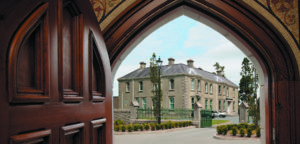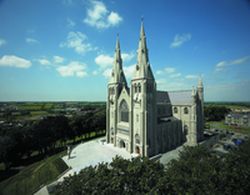LAUNCH OF VOCATIONS WEB SITE
‘A PILGRIM PATH’
ARMAGH DIOCESAN PASTORAL CENTRE, MOUNT OLIVER
7 MARCH, 2002
ADDRESS BY
MOST REV. SEÁN BRADY, DCL
I join in the welcome to you all here tonight. I thank you, not alone for your presence here tonight, but also for all your work for the life of the Church in the Archdiocese of Armagh. I want to record in particular my appreciation of your work for young people and the part you play in helping them to prepare for life and to find their appropriate role in life.
I thank and congratulate Monsignor McEntegart and the Vocations Commission on the production of this excellent website. I congratulate Marion Mulhall and her staff on the excellent standard of the final product.
I remember once hearing on radio a journalist saying how she would not lift a finger to halt what she termed the “decline” of the Church in Ireland. However, she did hope that there might be a priest to say a prayer with her as she lay dying. In a sense this epitomises the mindset of many people today. We are distracted in so many ways, attracted by the ephemeral, caught up in the immediate and the urgent, involved in so many issues and matters which clamour and compete for our attention.
Yet deep down there is a very definite thirst for the spiritual, which often we stubbornly refuse to acknowledge or satisfy. The sense of the Divine is deeply rooted in the human person. Various forces may conspire to limit the way we sense the Divine within the human soul and to constrain our response. But the sense of God in the human person cannot be extinguished. Humanity’s reliance on our own efforts, and trust in what we ourselves can achieve by our own knowledge and technology, expertise and organisation, are at an all-time high, and consequently there is very often little sense of a need for God. Yet September 11 last is an awful reminder to us how fragile the world order is – how easily a world of relative peace, pleasure-seeking and prosperity, at least in the Western hemisphere, can seriously be endangered. Someone said that the two groups of people most sought after in the United States after 11 September were the priests and the psychiatrists – which says something for the needs of the soul.
I am convinced that increasingly throughout the Western world we will see the limitations of modern society – high abortion rates, high marital breakdown, unjust structures, personal and communal living without a moral compass. Prosperity and a healthy GDP will in themselves not bring fulfilment to the human soul. A world separated from God can never be at ease with itself. I am convinced in this country that as we work out the “baggage from the past”, as in union with the Western world we increasingly see the limitations of this “brave new world”, the desire to return to God and to nurture the longing for God, will be great. Then the hunger for God in the human soul, the need for the Church and for priests, will never have been greater.
To present oneself for ordination today is not easy. It is truly to be a sign of contradiction. It is to be generous and courageous in a way not affirmed or endorsed by the world. However, I am convinced that those who take this step can be happy and deeply fulfilled in this most challenging of walks of life. I unreservedly encourage young people to listen to the call of the Lord and not to be afraid of it. The Third Millennium is a time of great hope. It is a time for bold and determined decisions. I hope that many will answer the call from God to the priestly ministry.
I often try to remember how I came to offer myself to go to Maynooth in 1957. The words of Jesus, “Pray the Lord of the Harvest to send labourers into his Harvest”, resonated with me. As a young lad I loved helping out at harvest time on my father’s farm – saving hay, cutting corn, picking potatoes. I had a sense of playing my part in ensuring that there was food for the livestock and an income for the family over the winter.
Later on I came to see that there is another hunger, one deeper than that of the body, that is the hunger for happiness. When it was suggested to me that I might have a part to play in satisfying that hunger and in giving to people the Words of Eternal Life and the Bread of Eternal Life – I am certain that this consideration was a factor in my decision to enter the seminary and train to become a priest.
Recently I was fascinated to watch those who were called by RTE to audition for a new Pop Band. There was sheer delight if successful, total desolation if rejected. I have been trying to work out what was the secret of this appeal of such a life-style. I think the answer is wealth and fame.
But Jesus, the Son of God, taught us that true happiness is not found in riches, nor in fame, nor in power, nor indeed in any human achievement but rather in God alone, the source of all that is good and of all love. He said, Blessed are the Poor; Blessed are the Meek.
Before returning to His Father, Jesus gave very specific instructions to his disciples:
“Go teach all nations.
Do this in memory of Me.
Feed my lambs; feed my sheep”.
Now Christ lives and acts in and with and through His Church. He acts through the Sacraments. The fruits of his death and resurrection are made available to us in the celebration of the Sacraments. Holy Orders is the sacrament through which the work entrusted by Christ to his apostles continues to be carried out. When I meet young people I often ask for questions. Inevitably I get two. What is it like to be an Archbishop and why did you become a priest? There is an abiding interest in the hearts and minds of many people about who priests are and what they do. A tiny tot put up his hand, in one class, and said, “I know who your friend is.” “Who is that?”, I said. “God”, he said. That certainly surprised me and delighted me and what could I say except, “I hope so”.
In this website three priests of our diocese, one from Tyrone, Fr Peter McAnenly, one from Armagh, Fr Eamonn McCamley, and one from Louth, Fr Oliver Brennan, speak of their life as a priest. They share with us something of the joy and the satisfaction, the challenges and the difficulties which they meet in priesthood. But I know them and I know they are totally convinced that they are doing an essential work for the lives of the people they serve. Yes, we are servants of Christ first of all and of His Church and servants of the people of our parishes in our diocese. Sometimes our service perhaps is not appreciated. The truth is often rejected but we must continue to offer that service and launch out into the deep. We must continue to raise people’s awareness of the need for priests, the need not only to pray for vocations, to ask the Lord to send labourers into His harvest, but to put the prospect before young people, young people that we think are suitable. Perhaps before we do that we should try and identify people whom we regard as potential candidates. Then we could bring them before the Lord, in prayer, and the same thought might present itself to them. Surveys have told us that many young people do consider priesthood even yet. The level of questioning in the classroom would suggest to me that there is an interest there. But perhaps we priests have short-changed our listeners. We don’t talk enough about the happiness that we experience.
A barrister pleads for people before the Court of the land. A priest pleads in prayer before the Court of Heaven for himself and for his people. Priests offer the Eucharist – the greatest prayer of all – the memorial of Christ’s saving death and resurrection. They have power to change bread and wine into the body and blood of Christ.
The aim of this Pilgrim Path website is to tell people what exactly a priest is, i.e., someone to whom Christ has entrusted a big job of work, a man of trust. The big task in question is that of continuing and carrying on the mission of Christ in the Church to the end of time. It consists of preaching His Word, celebrating His glory, dispensing His love and his pardon and his peace.
I like the title, Pilgrim Path. Life is a pilgrimage for us all. A spiritual life has often been described as a journey or a pilgrimage. Every human life is a mystery that unfolds, a promise that is gradually fulfilled. To be human is to be a pilgrim. The pilgrimage to priesthood is founded in the call addressed to Abraham, “Go from your country to the land that I will show you.” It is a pilgrimage where there are sometimes no road maps, no sign posts, sometimes no roads, but we know where we are going. We haven’t got the details of the journey but as pilgrims we have something more, we have the help of the Holy Spirit. The pilgrimage is also founded, of course, on the call of Christ, “Come follow Me”, and his assurance that He will be with His Church to the end of time.
I congratulate all those involved in this web site. I hope that the Pilgrim Path website might serve for some as a possible first port of call for information on the priesthood. I also hope that many young men and those who have greater experience of life will visit this site and find it useful. It is my prayer that those who feel that the Lord may be calling them to the priesthood, even if the call at this stage seems unclear and uncertain will find here food for thought and inspiration for prayer. I hope that those considering priesthood might find here something helpful to them in their own pilgrimage of faith and commitment to the Lord. It is also my desire that those who actively promote vocations to the priesthood and indeed all those who love the priesthood will find this site of interest.
I congratulate the three priests involved, Fathers Brennan, McCamley and McAnenly. The objective is to raise the awareness of people of the situation. We have nine seminarians at present. Three of these are due to be ordained deacons on Easter Monday next. Please God they will be ordained priests next year. The road to priesthood is a long road. It consists of six or seven years of third level education made up not only of study, but also of prayer and practical experience. A future priest has to grow in knowledge of God and in knowledge of himself and in knowledge of people. A future priest needs to be well prepared because the demands placed on priests these days are huge. The priest is a “wanted man”. He is wanted for baptisms and for funerals, for weddings and for wakes, for jubilees and celebrations of every kind.
If the supply is to continue then the foundations must be laid down. Vocations will come from a community of faith, people who believe in the Eucharist, who believe in the importance of the Mass. They will come from a community which sees that it really is the Mass which makes the Church, and which gathers together to worship and praise God. Vocations will come from homes where there is prayer, daily prayer, prayer of praise and thanks. Vocations come from families where there is generosity towards the poor and the needy. They come from people who are not full of self-love, but dedicated to the service of others, trained to sacrifice themselves and willing to conform their desires to God’s will. Vocations to priesthood come from people who are not full of self-love but dedicated to the love of God and the service of others.
Priests dedicate their lives to preaching His Word not their own word, not by their own authority but by the authority of Christ Jesus. We all love glory. Priests dedicate their lives to celebrating His glory, the glory that will never fade. Priests dedicate their lives to dispensing His love, a love that is so great that it brought Jesus to suffer and die for love of us.
When I was in Rome last October, Pope John Paul gave me a cross. It bears three Latin words, Duc in Altum. They mean, “launch into the deep”. Jesus spoke those words to Peter on the lakeshore. Peter had fished all night and had caught nothing. He wasn’t convinced that another try was going to yield a lot, but at the command of Jesus he was willing to try. The result is history. He caught “armfuls of fish”, as one young man told me earlier this week. The Holy Father urges us once again to launch out into the deep. We do so convinced that God continues to call people to serve Him in His Church and in the priesthood. We launch this website to challenge young men to see what path in life they will choose. Today some families are reluctant to encourage their sons to think about becoming priests. I can understand the reluctance but I would also like to call to mind that if God is calling somebody to do some good in this life, then I don’t think that person is going to be happy doing something else. Yes, the demands placed on the priest today are huge and are very heavy, but the returns are deeply satisfying and bring great happiness. I have been a priest for thirty-eight years – thirty-eight very happy years. I probably don’t spend enough time thanking God for all the happiness which my priesthood has brought me.
It is right that the priesthood of the Archdiocese should have a presence on the World Wide Web. I am very happy that we are employing the very latest and most sophisticated technology in bringing the idea of priesthood as a vocation to the world in this way. I am very grateful to the Armagh Diocesan Vocations Commission and their expert IT team who have worked so hard to make this site a reality. Pope John Paul II has spoken many times on the use of the Internet, encouraging local Churches throughout the world to avail of the Web as a tool of evangelisation. I am very happy that the Archdiocese of Armagh is engaging with the modern world in this most up-to-date of ways. I pray that this site may inspire and assist many men to be generous in the exciting vocational journey of answering the call to follow Christ in the ordained priesthood. I also hope that it will remind priests that the promotion of vocations must be a priority in their own life and work.


